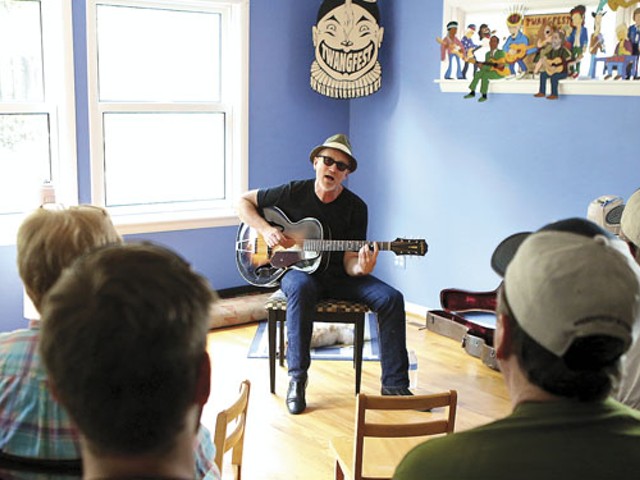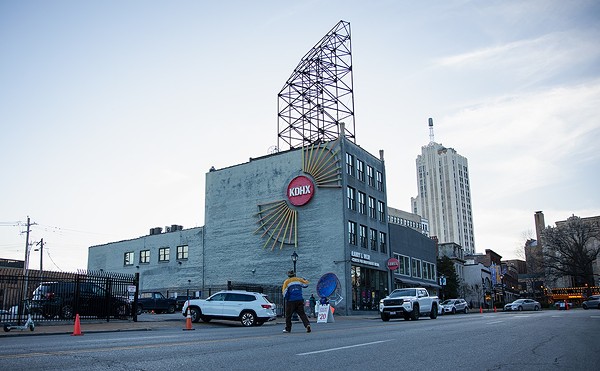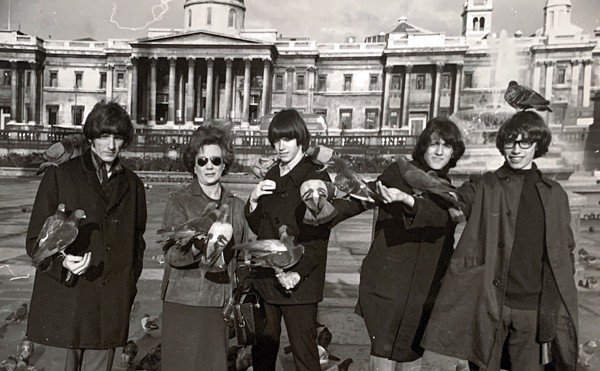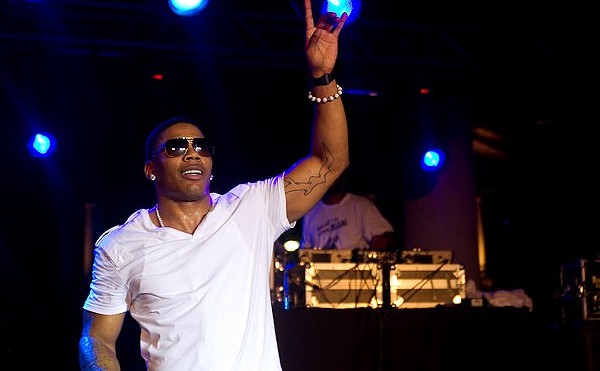At some level, you better know what you're doing, so you don't electrocute yourself," says Mark Sarich, executive director of the Lemp Neighborhood Arts Center. He speaks about Instinct Control, an artist from Chicago, who creates sound by touching exposed circuits on a stripped-out reel-to-reel tape recorder, which he hangs from his neck. Stalking around and encumbered by the box, Instinct Control confronts his audience with the noise produced by his body's electric current.
Instinct Control might be a headliner, if there were such a thing, at this weekend's Noisefest X. On November 1, 2 and 3, LNAC will host its tenth annual festival of experimental music. Fortunately for St. Louis, Noisefest has been a safety net for all those who identify with the wide-open genre of noise.
What does it mean to be a noise artist? In the same way the term "indie" no longer means "independent," "noise" doesn't describe a total lack of music. For those who claim that name, noise is a catchall term for that which is hard to define. Describing a sound as "noise" is a challenge to the listener to shun assumptions of what they might see or hear. Anything can qualify as noise.
Noisefest was created out of necessity. In the early aughts, noise had been a blip in the Midwest, and hardcore music was the lifeblood of LNAC. Sarich started getting requests from bands using the word as a self-descriptor, often paired with "experimental." When Sarich would ask if one band knew the other, the common answer was no. Seeing these fragments of invention scattered through the region, Sarich headed a collected effort to connect the dots.
"It became clear to me that really significant music was happening here, and it was an opportunity for everyone to get to know each other and for us to generate a whole artistic scene," explains Sarich. "The first year, I took all the e-mail addresses of all the bands who had played and printed them in a little booklet that I gave to every one of the performers."
In subsequent years, the event evolved into a meeting of the minds, producing a game of one-upsmanship in the spirit of creation. Noisefest generally followed a similar pattern from year to year: Three concerts over a three-day weekend. Reserve two-thirds of the show for established bands and the final third for emerging acts. In this way, the fest is held with integrity and identity, but it also allows for new ideas.
As interest spiked, Sarich added a fourth concert to Noisefest. Now, Sunday would include an artist's discussion in the morning, an afternoon matinee and the fest's closing show in the evening.
Because of its open nature, noise is vulnerable to bandwagoners. "It reached a sort of critical mass where a lot of people were involved because it was cool. They weren't really listening. They didn't know what they were really listening to, even," Sarich says. "You started getting what I refer to as kids doing stuff 'noise artists are supposed to do.' They were not being creative, which is what it's supposed to be in the first place. They were just sort of replicating something they already heard."
Over the years, Sarich and the LNAC have repeatedly snubbed the idea of noise as a mere trend or fad. Despite a marked decline in attendance Noisefest remained, but not without help from people like Peter Woods of Milwaukee, Wisconsin. Having performed at every Noisefest between 2005 and 2010, Woods became a major player behind the scenes. His work with Sarich inspired a Milwaukee version of Noisefest based in the Borg Ward, an all-ages space not unlike LNAC. "My real goal was to try and take what Mark had set out to do and keep that alive," Woods says. "I see the event as a meeting ground, a conference almost."
"I think being at the fest in St. Louis made me realize how transformative of an event a festival can be," Woods says of the impact of Noisefest and its format. "It's a place where like-minded musicians and audience members can share ideas, a process that almost trumps the performances actually happening." And although the festival feeds a niche, its doors are open because the sounds therein are always open to interpretation.
The most common theme within the genre is the tendency to challenge the listener. With much of what we hear, accessibility is key. Noise calls on its audience to instead meet halfway. "This is an experience; it's not a thing to be consumed. You go to see something you've never seen before, feel something that rings true and makes you think," Woods says. He will be returning to Noisefest this Saturday, alongside a lineup of mostly out-of-towners.
In recent years, Noisefest has seen a thinning of the herd. In 2011 Noisefest shrunk down to a one-day festival. Sarich views the last two years as a time of refinement and 2013 as a return to form. Of special note is Nathan Cook, a local performer whose contributions are key to this year's fest. "He is one local guy I see and say, 'Wow,'" Sarich says. "Every time he performs, it's a learning experience."
In addition to running a small experimental music label, Nathan Cook is an active performer who, since 2003, has been pushing the boundaries of what it means to be a noise artist. Noise tends to be typecast as the archetypical opposite of music, a harsh, loud and mostly unlistenable thing. Cook's own music bucks that belief, and his contribution as curator this year reflects that.
"Despite the name, it is a very diverse genre, encompassing characteristics and fragments of a range of styles from rock and classical to ambient and even techno, most recently," Cook explains. "Not all of it is loud, either." Cook brought the biggest change for Noisefest X: The Sunday matinee has been transformed into a visual showcase for six area artists — a Noisefest first.
"It's a focus that Noisefest hasn't had in the past, and since it is the tenth anniversary of the festival, I thought it would be fitting to have a special presentation as a testament to the outstanding experimental works of image and sound that these St. Louis artists have been refining over the last few years," Cook says.
Woods and Cook are certainly pillars of Noisefest, but there is one individual whom Sarich deems ultimately responsible: Chris Smentkowski of the seminal noise group Brain Transplant. "If it wasn't for Chris, I wouldn't even be doing Noisefest. He was the one who introduced me to the whole thing. He came to me and said, 'I want to do some shows. How do you feel about this?' I owe it all to him. Seriously. I owe him more than..." Sarich stops short, takes a deep breath and continues. "I booked my first show because of Chris."
Brain Transplant performed at the first Noisefest and will appear again this Sunday, one decade later.
Other performers include Ghost Ice and the Night Grinder, two individuals who have been named Best St. Louis Noise Artist by Riverfront Times. Genre veterans aren't the only ones invited — the heads behind Noisefest maintain the policy of inviting new and emerging bands. There is even an act, the Fluff of Murder, that will play for the first time in a live setting.
"After ten years of Noisefest, is it still as crazy as it ever was?" Sarich asks, rhetorically. "Well, of course! It's experimental; it has to be!"






